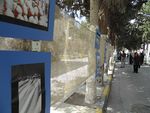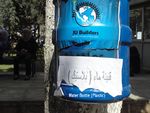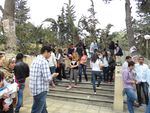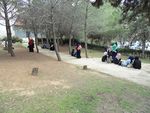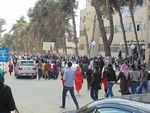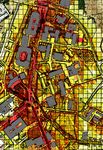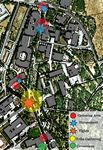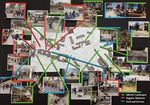Landscape Democracy 2015 Working Group B - Case Study 3
---> back to group page working group B
University of Jordan Campus University of Jordan in the oldest and largest universities in Jordan in student capacity, hosting more than 31,000 students, and sitting in the heart of Amman the capital, on a spacious area of 1,200 thousand square meters. The land is changing between flat and mildly sloped, giving unique spatial experiences and theatrical changes of scenery between different spaces. The landscape is abundantly composed of pine and elm trees, as well as olive and other kinds of trees in some areas. The campus is semi-rectangular in shape and at its center students can find most of the facilities and services.The northern part of the campus is occupied by the dormitories for female students and faculty members housing units in the east and in the west the land is occupied by Humanities buildings. The southern part of the campus is occupied by the engineering, science and medical faculty buildings as well as the university hospital.
| Place name | University of Jordan Campus | |
| Location | Amman | |
| Country | Jordan | |
| Author | Eliza Salman | |
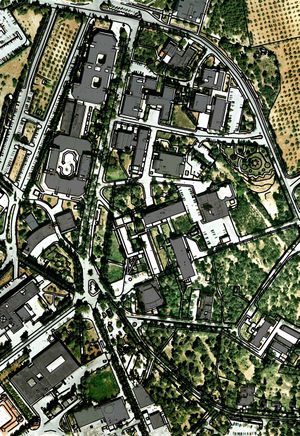
| ||
|
| ||
Rationale: Why have you chosen this case for the landscape and democracy seminar?
Landscape on the campus site of the University of Jordan, is rich and abundant in spaces where students can sit, walk, communicate as well as express themselves in many ways. Walkways and open spaces are sometimes used to exhibit artwork, certain points are gathering areas for poetry afternoons, and groups of friends enjoy playing the guitar in some corners of the landscape, or sunbathe under the warm spring sun in grassy areas. Some spaces are even used as starting points to running or cycling races. But it seems that all of that is not enough to provide a safe and hospitable environment, and a campus free of violence and harassment.
- Site Observations
Many efforts were tried to eliminate the violence tendencies of some students, like further screening students that are accepted to the university, and not allowing outsiders to enter the campus unless they have a student card or a special permit, awareness campaigns of the negative effects of student violence, as well as punishing students that cause trouble on campus. But these efforts were met with increasing violence. All of the efforts that were tried where on managerial bases, of what the policy makers thought was a fit solution for the problem. However, public opinion, participation, and social conversations were never considered. Therefore I thought this case study was fit for the subject of the seminar.
- Site Observations
Representation of your observations
- Student density is highest on the streets, and in front of building entrances, as well as around food service areas.
- On the site there are several designed gardens, intended for students to use and gather in, as well as areas that are left with pine and elm trees left in a natural style.
- Students redefined their own spaces, it is observed that they do not use all of the designed areas, some of them are abandoned, while other spaces that were left not designed were used by different groups of students for various functions.
- Crowded areas in front of building entrances as well as close to food service areas are usually where most occurrences of violence and gender-based harassment are common.
- Design Synthesis Drawings
Reflection
What are the major challenges for changing the situation?
Lack of awareness of the importance of democracy and public participation in decision making:
The average person in the community does not know nor believes that certain problems can be solved through societal conversation, and public participation in place making.
Abundance of economic and social problems that deviate the attention of the local community from the problem of violence in the university site:
Jordan as a developing country is facing many economic, and social problems, as well as inefficiency of infrastructures, which deviates the attention of people as well as the policy makers from problems related to the environment, as well as certain social problems like gender based harassment and violence in universities.
Accepting the problem as it is without real attempts to solve it:
People as well as policy makers blame the parents for failing at properly raising their kids, as well as the poor economical situations of many underprivileged families, that are believed to be the leading causes of violence in universities, the problem is not addressed any further. The management of the universities do not want to take the blame for it, not carry the burden of providing real and effective solutions for the problem.
Corruption on the level of policy makers that prevents certain solutions of being implemented:
In many cases, students that caused violence on the university campus were expelled from the university, only to be accepted again as a result of external pressure of some of the students connections. which encourages these students commit violent acts again, knowing that they will be able to escape the punishment.
Students do not feel pride and sense of ownership of their own university campus:
The violent acts that some student commit lead in many cases of destruction of public property, which these student do not feel that they are responsible for, nor feel that they own them and they have to take care of them.
Solutions that do not seem to solve anything:
Many of the attempts that were taking to try to eliminate the problem are not working, and seem to cause even more problems, like limiting the access of the campus only to students, to prevent any outsiders to enter the site. And this only seems to make the problem bigger, as many outsiders attempt to sneak in.
What could be a starting point for democratically-based change?
Student and public participation in finding solutions:
Engaging the student body as well as the society in conversations to find real solutions for the problems of the campus, as well as making the site open access to all citizens to enjoy, instead of social segregation and making it a forbidden place, this may increase the sense of responsibility of the public as well as students towards the site, as well as balance between different social classes.
Student participation in making their own places and improving the campus:
Allowing student to change and redesign the spaces in a way that they can benefit from, it may be on a managerial level by making a project to improve the campus a graduation prerequisite for all students, or as a community service project for students that are known for causing problems instead of expelling them and trowing them into more problems. This will fill the students' extra time with work that is not only beneficial, but also increases their sense of achievement, and responsibility towards the campus and public property.
References
Books and Studies:
- Maraqa, Oehring, (2013), Violence at Jordanian Universities, The First Media Company, Konrad-Adenauer Stiftung Amman, found at http://www.kas.de/jordanien/en/publications/38294/.
- Al-Louzi, Farhan, (2009), Students’ Violence at the University of Jordan, Jordan Journal of Social Sciences, Volume 2, No. 2, Pages 288-296. Found at http://journals.ju.edu.jo/JJSS/article/view/848/843.
News and Websites:
- University of Jordan, (2015), Campus Life, founf at the Official university website: http://ju.edu.jo/Home.aspx.
- GNRD News, (2015), YYGNRD-Jordan event Let’s Stop University Violence, found at http://www.gnrd.net/seemore.php?id=1277.
- Generations for Peace, (2015), HRH Prince Feisal Al Hussein congratulates University of Jordan students and officials tackling violence, found at http://www.generationsforpeace.org/en/hrh-prince-feisal-al-hussein-congratulates-university-of-jordan-students-and-officials-tackling-violence/.
- University of Jordan, (2012), Facts and Figures 2011/2012, found at http://ju.edu.jo/FactsAndFigures/Facts%20and%20Figuers.pdf.
About categories: You can add more categories with this tag: "", add your categories

